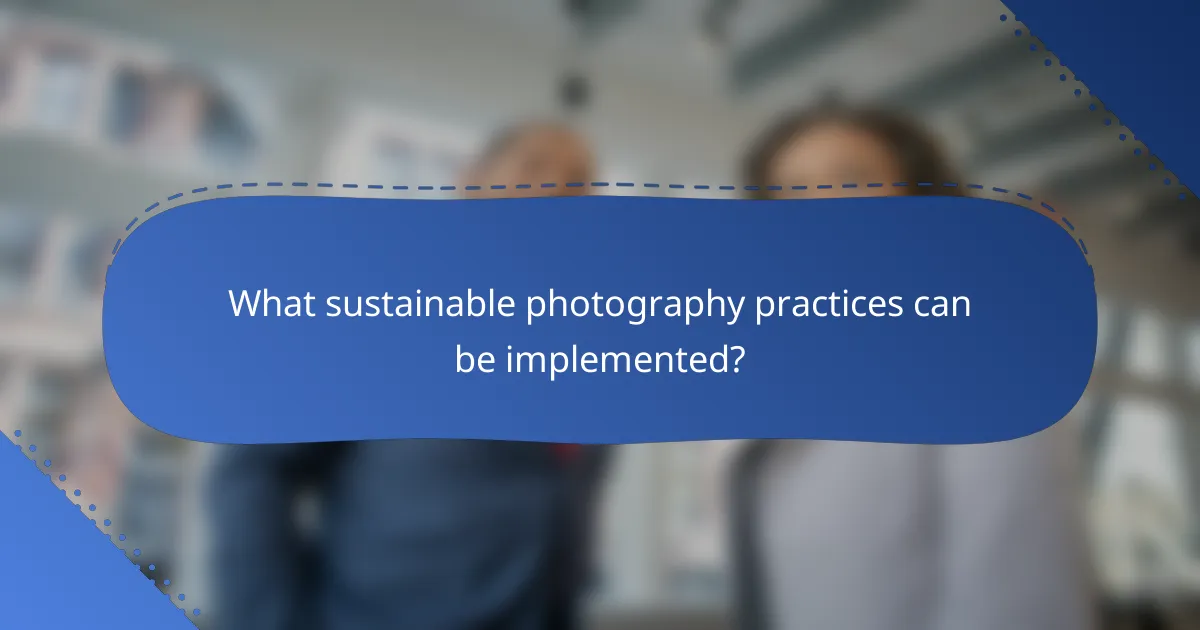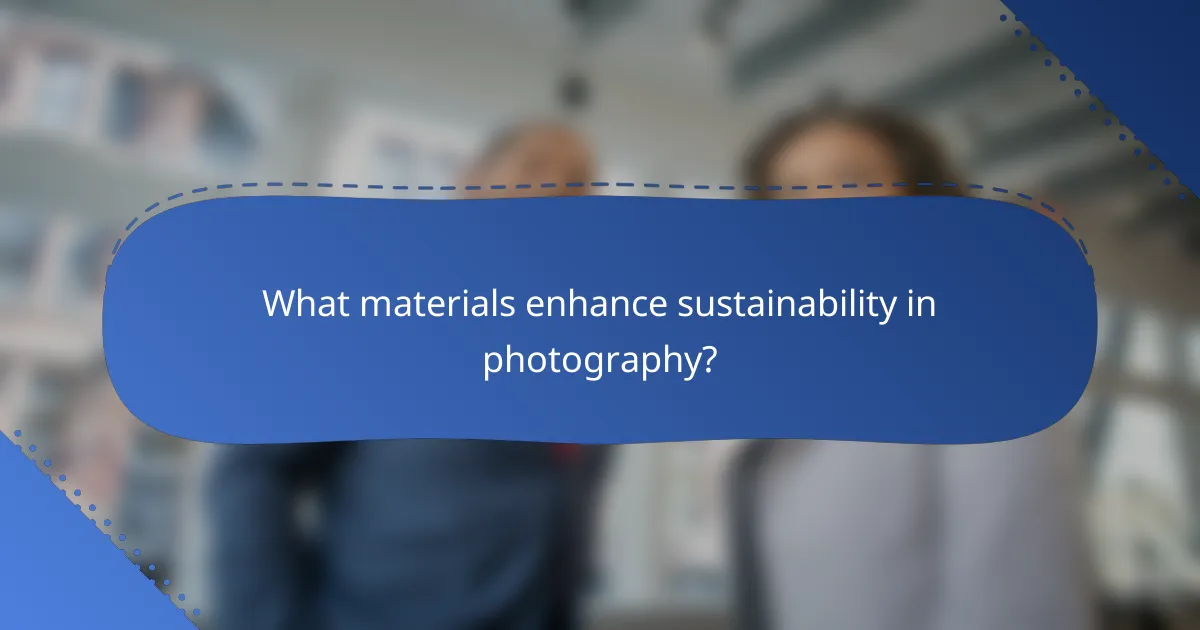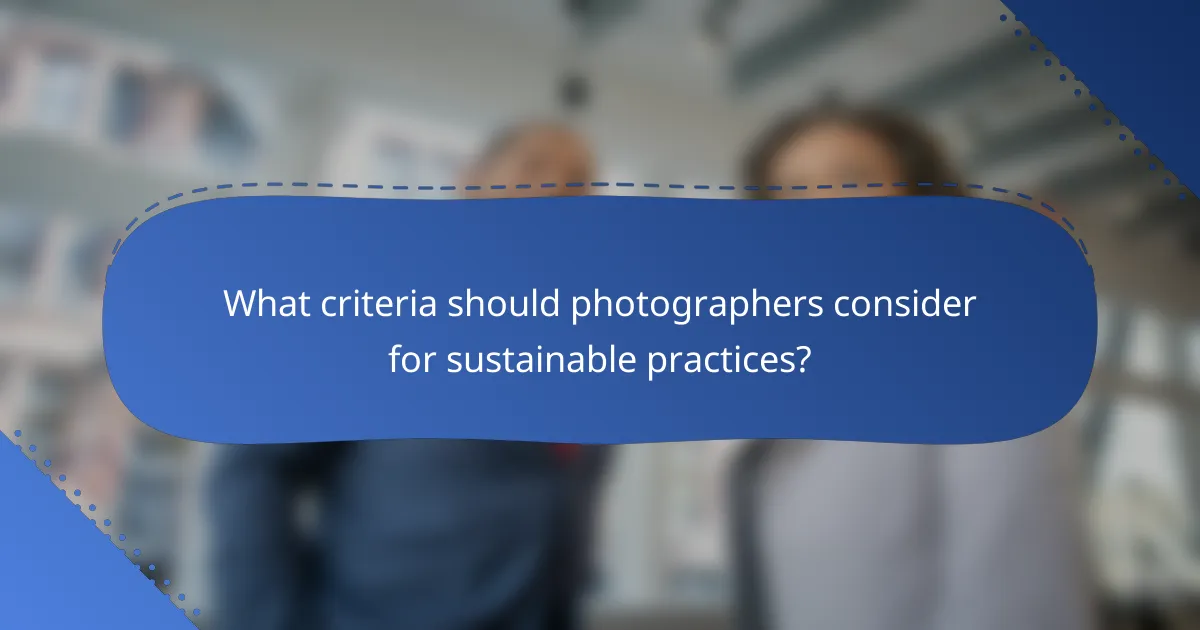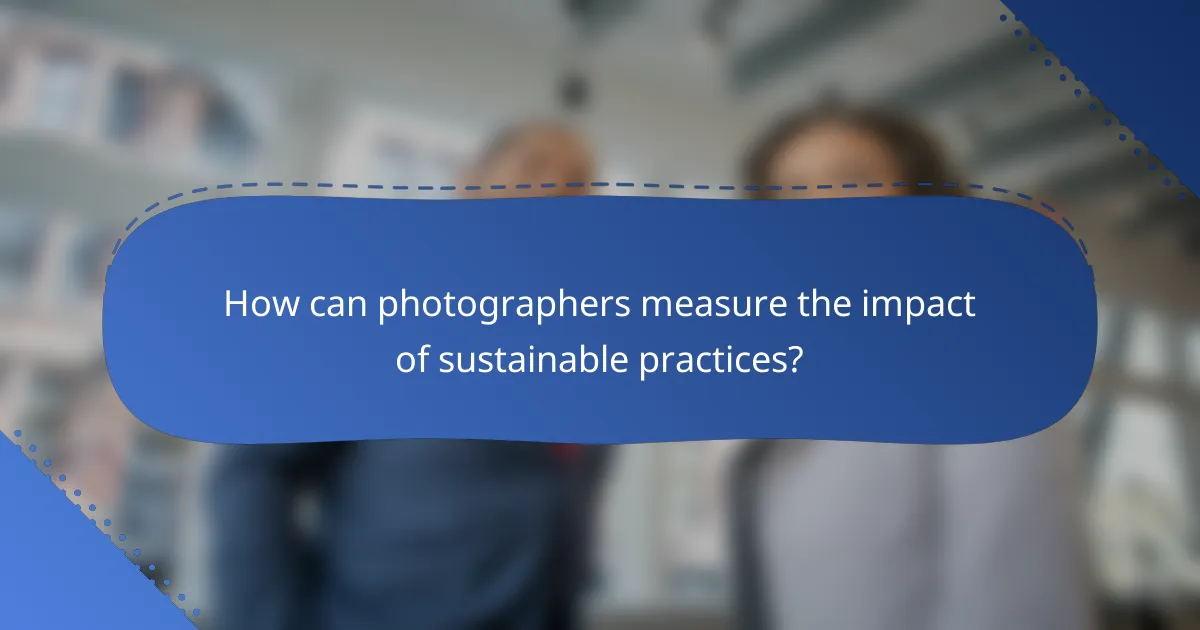Sustainable photography practices aim to reduce environmental impact while delivering exceptional visual narratives. By utilizing eco-friendly materials and techniques, photographers can not only lessen their ecological footprint but also attract clients who value sustainability. This approach not only enhances brand reputation and customer loyalty but also fosters unique storytelling that distinguishes businesses in a competitive landscape.

What sustainable photography practices can be implemented?
Sustainable photography practices focus on minimizing environmental impact while maintaining high-quality visual storytelling. By adopting eco-friendly techniques and materials, photographers can contribute to a healthier planet while appealing to environmentally conscious clients.
Use of natural lighting
Utilizing natural lighting is a key sustainable photography practice that reduces reliance on energy-consuming artificial lights. Photographers can schedule shoots during golden hours—early morning or late afternoon—when sunlight is soft and flattering. This not only enhances image quality but also lowers electricity usage.
To maximize natural light, consider scouting locations that offer ample daylight and reflectors to enhance brightness. Avoiding heavy equipment can further minimize your carbon footprint.
Digital editing techniques
Digital editing techniques can significantly reduce waste by allowing photographers to refine images without the need for physical prints. Using software like Adobe Lightroom or Photoshop, photographers can adjust exposure, color balance, and cropping to achieve the desired look. This minimizes the need for reshoots and excessive printing.
Additionally, consider adopting a non-destructive editing workflow, which preserves original files and allows for future adjustments without additional resource consumption.
Eco-friendly locations
Selecting eco-friendly locations for shoots can enhance sustainability efforts by minimizing travel and supporting local ecosystems. Choose sites that promote conservation or have sustainable practices in place, such as parks or community gardens. This not only reduces your carbon footprint but also aligns your work with environmental values.
When possible, collaborate with local businesses or organizations that prioritize sustainability, which can provide unique backdrops while fostering community support.
Minimal waste strategies
Implementing minimal waste strategies involves reducing physical materials and packaging used during shoots. Photographers can opt for digital contracts and invoices to eliminate paper waste. When physical props are necessary, choose reusable items or borrow from local sources instead of purchasing new materials.
Consider creating a checklist to ensure all equipment is accounted for before and after shoots, reducing the likelihood of lost items that may need to be replaced.
Community engagement
Engaging with the community can amplify the impact of sustainable photography practices. Collaborate with local artists, environmental groups, or schools to promote awareness of sustainability through your work. Hosting workshops or exhibitions can educate others about eco-friendly practices and inspire collective action.
By building relationships within the community, photographers can also gain access to unique locations and resources, enhancing both their portfolio and their commitment to sustainability.

What materials enhance sustainability in photography?
To enhance sustainability in photography, consider using materials that minimize environmental impact, such as recyclable camera gear, biodegradable props, eco-conscious printing options, and sustainable packaging solutions. These materials not only reduce waste but also promote a more responsible approach to photography.
Recyclable camera gear
Recyclable camera gear includes equipment that can be returned to manufacturers for recycling or repurposing. Look for brands that offer take-back programs for old cameras and lenses, ensuring that materials like metals and plastics are reused rather than ending up in landfills.
When purchasing new gear, consider options made from recycled materials or those designed for easy disassembly. This not only supports sustainability but can also enhance the longevity of your equipment.
Biodegradable props
Using biodegradable props in photography helps reduce plastic waste. Look for items made from natural materials, such as wood, cotton, or paper, which will break down over time without harming the environment.
When sourcing props, consider local artisans or suppliers who focus on sustainable practices. This not only supports the local economy but also reduces the carbon footprint associated with shipping materials from distant locations.
Eco-conscious printing options
Eco-conscious printing options include using recycled paper and non-toxic inks for prints. Many printing companies now offer environmentally friendly alternatives that maintain quality while minimizing environmental impact.
When selecting a printer, inquire about their sustainability practices, such as energy-efficient processes and waste reduction strategies. This ensures that your final products align with your commitment to sustainability.
Sustainable packaging solutions
Sustainable packaging solutions involve using materials that are recyclable, compostable, or made from recycled content. Opt for packaging that reduces waste, such as minimalistic designs or reusable containers.
When shipping prints or products, consider biodegradable packing peanuts or recycled cardboard boxes. This not only protects your items but also demonstrates a commitment to eco-friendly practices to your clients.

How do clients benefit from sustainable photography?
Clients benefit from sustainable photography through enhanced brand reputation, increased customer loyalty, and a positive environmental impact. These advantages not only resonate with eco-conscious consumers but also create unique storytelling opportunities that set brands apart in a competitive market.
Enhanced brand image
Utilizing sustainable photography can significantly enhance a brand’s image by showcasing a commitment to environmental responsibility. Clients who adopt eco-friendly practices in their visual content can attract consumers who prioritize sustainability, thus improving their market position.
For example, brands that use biodegradable materials for props or energy-efficient lighting can promote their eco-conscious values through their imagery. This alignment with sustainability can lead to a more favorable public perception and increased brand trust.
Increased customer loyalty
Brands that engage in sustainable photography often see increased customer loyalty as consumers feel a deeper connection to companies that share their values. When clients demonstrate a commitment to sustainability, they foster a sense of community among like-minded customers.
Implementing practices such as using local resources or supporting environmental initiatives can further solidify this loyalty. Customers are more likely to return to brands that they believe are making a positive impact on the planet.
Positive environmental impact
Sustainable photography practices contribute to a positive environmental impact by reducing waste and minimizing carbon footprints. Clients can choose materials that are recyclable or sourced sustainably, which helps decrease the overall ecological footprint of their projects.
For instance, opting for digital formats over physical prints can significantly lower resource consumption. By prioritizing eco-friendly methods, clients not only benefit their brand but also contribute to broader environmental conservation efforts.
Unique storytelling opportunities
Sustainable photography provides unique storytelling opportunities that allow brands to differentiate themselves in the marketplace. By highlighting their sustainable practices, clients can craft compelling narratives that resonate with consumers on an emotional level.
For example, a brand might showcase the journey of sourcing materials responsibly or the impact of their eco-friendly initiatives through visual storytelling. This approach not only engages audiences but also reinforces the brand’s commitment to sustainability, creating a memorable connection with consumers.

What criteria should photographers consider for sustainable practices?
Photographers should focus on eco-friendly materials, client expectations, and compliance with local regulations to ensure sustainable practices. These criteria help minimize environmental impact while meeting the needs of clients and adhering to legal standards.
Client expectations
Clients increasingly prioritize sustainability in their projects, often seeking photographers who share their values. Understanding these expectations can enhance client relationships and lead to repeat business.
Communicate your sustainable practices clearly, such as using eco-friendly materials or reducing waste. Providing examples of past work that align with these values can also help build trust and attract like-minded clients.
Material sourcing
Choosing sustainable materials is crucial for reducing a photographer’s ecological footprint. Opt for products made from recycled or biodegradable materials, such as eco-friendly paper for prints and non-toxic inks.
Consider sourcing locally to minimize transportation emissions and support regional economies. Research suppliers who prioritize sustainability and are transparent about their sourcing practices.
Local regulations
Familiarizing yourself with local regulations regarding waste disposal, chemical use, and energy consumption is essential for sustainable photography. Many regions have specific laws that govern environmental practices, which can impact your operations.
Stay updated on any changes in regulations and ensure compliance to avoid fines and enhance your reputation. Engaging with local environmental organizations can also provide valuable resources and support for sustainable initiatives.

How can photographers measure the impact of sustainable practices?
Photographers can measure the impact of sustainable practices by evaluating their resource usage, waste production, and carbon footprint. Key metrics include energy consumption, material sourcing, and the lifecycle of products used in their work.
Energy Consumption
To assess energy consumption, photographers should track the electricity used for lighting, equipment, and post-processing. Using energy-efficient lighting and equipment can significantly reduce overall usage. For example, switching to LED lights can cut energy consumption by up to 75% compared to traditional bulbs.
Material Sourcing
Evaluating material sourcing involves examining the origins of photographic supplies such as paper, chemicals, and digital storage. Opting for sustainably sourced materials, like recycled paper or eco-friendly inks, can lessen environmental impact. Photographers might consider local suppliers to reduce transportation emissions.
Carbon Footprint
Calculating the carbon footprint requires assessing all activities associated with a photography project, including travel, equipment manufacturing, and waste disposal. Online carbon calculators can help estimate emissions. Photographers can offset their footprint by investing in carbon credits or supporting reforestation projects.
Waste Production
Measuring waste production involves keeping track of discarded materials, including prints, packaging, and expired chemicals. Implementing a waste reduction strategy, such as recycling and composting, can minimize this impact. Photographers should aim to reduce waste by digitizing their workflow and using minimal packaging.
